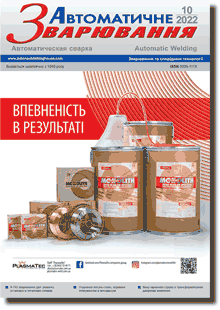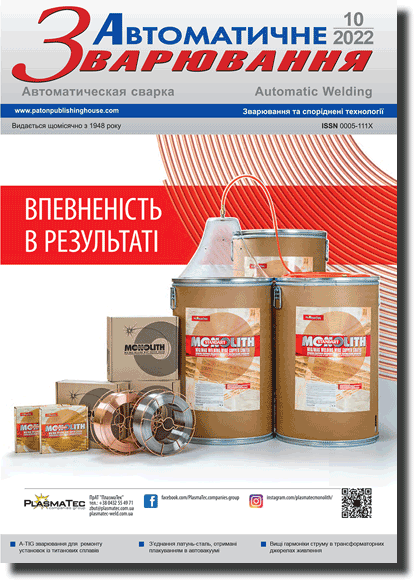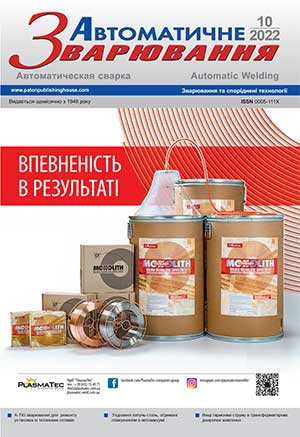| 2022 №10 (03) |
DOI of Article 10.37434/as2022.10.04 |
2022 №10 (05) |

"Avtomatychne Zvaryuvannya" (Automatic Welding), #10, 2022, pp. 29-34
Characteristics of formation and properties of brass-steel joint produced by autovacuum cladding
I.P. Serebryanyk, M.A. Poleshchuk, T.O. Zuber, A.I. Borodin, A.Yu. Tunik, O.A. Los
E.O. Paton Electric Welding Institute of the NAS of Ukraine. 11 Kazymyr Malevych Str., 03150, Kyiv, Ukraine. E-mail: office@paton.kiev.ua
The technological features of producing brass-steel joint by the method of autovacuum heating are considered. The thickness of the brass layer after mechanical treatment was 10 mm. Studying the structures and chemical composition of various joint zones confi rmed the solution-diff usion nature of interaction of liquid brass with steel. The measurements of microhardness showed the absence of hard and brittle structures. A high quality of the joint was confi rmed by mechanical tests of the two-layer joint on static bending, rupture and shear. 17 Ref., 2 Tabl., 8 Fig.
Keywords: brass, steel, two-layer joint, autovacuum heating
Received: 11.07.2022
References
1. Kolesov, S.N., Kolesov, I.S. (2007) Materials science and technology of structural materials. In: Manual for inst. for higher educ., 2nd Ed., Moscow, Vysshaya Shkola [in Russian].2. Golovanenko, S.A., Meandrov, L.V. (1966) Production of bimetals. Moscow, Metallurgiya [in Russian].
3. (2003) Handbook on soldering. Ed. by I.E. Petrunin, 3rd Ed., Moscow, Mashinostroenie [in Russian].
4. GOST 31842-2012. Shell-and-tube heat exchangers. Technical requirements [in Russian].
5. Serebryanik, I.P. (2011) Autovacuum noncapillary structural brazing. Kyiv, Alfa-Reclama [in Russian].
6. GOST 19281-89. Rolled steel with increased strength. General specifications [in Russian].
7. GOST 15527-2004. Pressure treated copper zinc alloys (brasses). Grades [in Russian].
8. Bogomolova, N.A. (1978) Practical metallography. Moscow, Vysshaya Shkola [in Russian].
9. Perevezentsev, B.N., Krasnopevtsev, A.Yu., Fedorov, A.L. (1991) Study of zinc evaporation in brazing by copper-zinc braze alloys. In: Abstr. of Papers of All-Union Sci.-Tech. Conf. on Brazing in Mechanical Engineering, Tolyatti [in Russian].
10. GOST 5.9311-78. Explosion welding of metals. Bimetallic billets for tube plates of heat exchange apparatuses. General specifications.
11. (1971) Welding of steel structures. In: Production of large structures, Issue 20. Ed. by A.I. Volkonsky. Trudy NPI TyaZhMash, Uralmashzavod [in Russian].
12. Shmidt, M., Kuryntsev, S.V. (2014) Producing of bimetal joints by laser welding with full penetration. The Paton Welding J., 4, 45-48. https://doi.org/10.15407/tpwj2014.04.07
13.Suvorin, A.V. (2011) Electrotechnological installations. Krasnoyarsk, SFU [in Russian].
14. Poleschuk, M.A., Atroshenko, M.G., Puzrin, A.L., Shevtsov, V.L. (2014) Estimation of possibility for producing full-strength joint of large steel parts using the method of autovacuum brazing of threaded profi le. The Paton Welding J., 10, 35-37. https://doi.org/10.15407/tpwj2014.10.07
15. Vajnerman, A.E. (1981) Mechanism of intercrystalline penetration in surfacing of copper alloys on steel. Avtomatich. Svarka, 6, 22-29 [in Russian].
16. Serebryanik, I.P., Atroshenko, M.G., Poleshchuk, M.A. et al. (2018) Properties of steel-copper bimetal produced by brazing in autonomous vacuum. The Paton Welding J., 5, 12-16. https://doi.org/10.15407/tpwj2018.05.03
17. GOST 14019-2003. Metallic materials. Method of bending tests.
Advertising in this issue:
The cost of subscription/purchase order journals or individual articles
| Journal/Currency | Annual Set | 1 issue printed |
1 issue |
one article |
| TPWJ/USD | 384 $ | 32 $ | 26 $ | 13 $ |
| TPWJ/EUR | 348 € | 29 € | 24 € | 12 € |
| TPWJ/UAH | 7200 UAH | 600 UAH | 600 UAH | 280 UAH |
| AS/UAH | 1800 UAH | 300 UAH | 300 UAH | 150 UAH |
| AS/USD | 192 $ | 32 $ | 26 $ | 13 $ |
| AS/EUR | 180 € | 30 € | 25 € | 12 € |
| SEM/UAH | 1200 UAH | 300 UAH | 300 UAH | 150 UAH |
| SEM/USD | 128 $ | 32 $ | 26 $ | 13 $ |
| SEM/EUR | 120 € | 30 € | 25 € | 12 € |
| TDNK/UAH | 1200 UAH | 300 UAH | 300 UAH | 150 UAH |
| TDNK/USD | 128 $ | 32 $ | 26 $ | 13 $ |
| TDNK/EUR | 120 € | 30 € | 25 € | 15 € |
AS = «Automatic Welding» - 6 issues per year;
TPWJ = «PATON WELDING JOURNAL» - 12 issues per year;
SEM = «Electrometallurgy Today» - 4 issues per year;
TDNK = «Technical Diagnostics and Non-Destructive Testing» - 4 issues per year.









